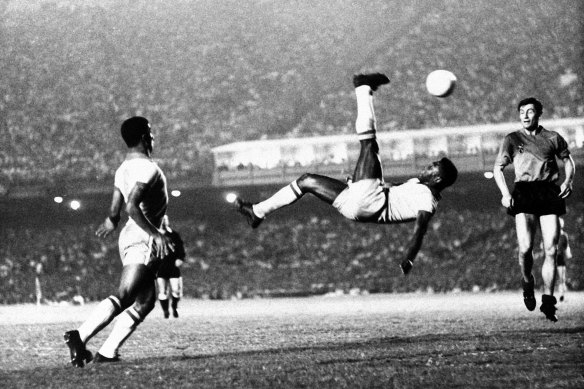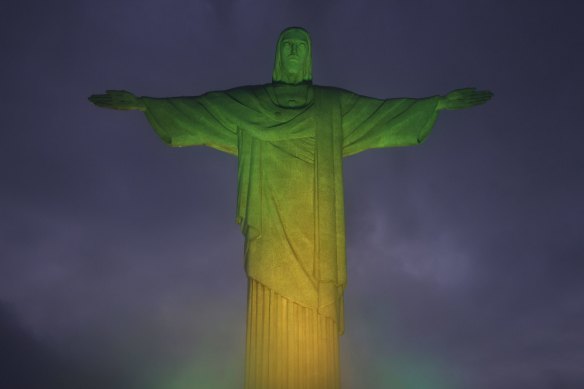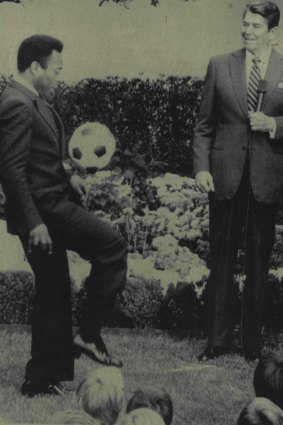This was published 1 year ago
Pele was Brazil, Brazil was Pele: How a country found itself in a sport hero
By Tariq Panja
New York: The young soccer players who were gathered on the lush green grass of the White House Rose Garden were buzzing even before the president of the United States took hold of the microphone. Even the president knew they had not come to see him.
“Oh, by the way,” the president began, almost as an aside, “my name’s Ronald Reagan”.
The Brazilian football star next to him needed no introduction. Everyone knew Pele.

Pele performs a bicycle kick in 1968.Credit: AP
He had met, by then, three US presidents, starting with Richard Nixon a decade earlier, and he would go on to meet several more. Each visit cemented the role of Pele, who died on Friday (AEDT), as not just the world’s best football player but also as a living embodiment of his country. He was, for most of his 82 years, Brazil’s representative to the world and a source of pride to a nation that found itself, thanks in part to the magic in the feet of the 17-year-old wunderkind who fired it to its first World Cup championship in 1958.
Brazil has identified with – and been identified with – Pele ever since. It is hard to overstate the meaning of the connection between the individual and the country, a link that endured at his death almost as strongly as it did in Pele's heyday, when he was among the most famous people in the world. For a country still looking to make its mark in the postwar years, Pele’s arrival signalled Brazil’s coming-of-age.

Rio de Janeiro’s Christ the Redeemer statue is lit with the colours of the Brazilian flag to pay homage to Pelé.Credit: Getty Images
When he arrived in Sweden for the 1958 World Cup, Pele frequently recalled, he was surprised at how little people knew about the place that had produced him, a country he had believed to be the best in the world.
That view was not widely shared in Brazil. The nation was burdened in those days with the so-called “complexo de vira-lata” (stray dog syndrome), a term coined by writer Nelson Rodrigues after Brazil’s humiliation on home soil in the final game of the 1950 World Cup. That defeat, Rodrigues wrote, exemplified a collective inferiority complex that Brazil saw in itself, not just in soccer but in its relationship with the rest of the world.
“Here is the truth,” Rodrigues wrote. “We can’t find personal or historical pretexts for self-esteem.”
The same writer, however, said just before the team headed to Sweden eight years later that it had finally found in its young star a figure to lift spirits and to turn Brazil into a nation of which its citizens could finally be proud.

A lesson from the master: US president Ronald Reagan and Washington soccer players watch Pelé in the Rose Garden at the White House in 1982.Credit: AP Laserphoto/File
“With Pele on the team, and others like him, no one will go to Sweden with the souls of stray dogs,” Rodrigues wrote. “The others will tremble before us.”
They did just that.
That first world championship delivered to Brazil the type of recognition it craved, and in Pele it found a talent whose brilliance set him, and the Brazilian people, apart. Brazil’s canary yellow shirts and Pele's dazzling play became synonymous with the country itself, its calling cards to the world.
As Brazil won a second title in 1962 and a third in 1970, Pele came to personify a period of sustained success on the soccer fields that was matched by an economic boom at home and the rise of bossa nova, a style of samba music from Rio de Janeiro that swept through the globe like a current of electricity. Brazil’s confidence was sky-high then, and in Pele the nation had found “O Rei”, its king, a nickname that would be attached to him until his last breath.
In Brazil, Pele’s feats, successes and celebrity meant so much more given where he had come from and – whether he embraced it or not – whom he represented.
Brazil, in 1888, was the last Western country to abolish slavery, and Pele was born just 52 years later, a poor black child who started out life shining shoes.
His journey to national hero, after his explosion onto the global consciousness as a teenager, was particularly meaningful for Brazil’s black population and for its poor. His popularity also lifted him above the fray of domestic issues, soccer royalty in a nation still finding its way.
Pele, sometimes to the frustration of activists, rarely spoke out about racism during his playing career or afterwards. He would often repeat the consensus view that Brazil was, in fact, a “racial democracy”, a position that has been challenged with the growth of the black consciousness movement. His refusal to take political stands also stood out in a period when Brazil was ruled by a series of dictatorships, during which the military sought to take advantage of soccer’s popularity to sustain its hold over the country.
“I thought his behaviour was that of a black person who only said, ‘Yes, sir’, a black person who is submissive, accepts everything,” Paulo Cézar Lima, a former teammate on the Brazilian national team, said in a 2021 Netflix documentary made with Pele. “A single word would have meant so much in Brazil.”
Yet to some of his other compatriots, Pele’s very presence as a globally recognised black Brazilian was enough. Taking on a dictatorship, after all, carried risks.
Pele’s legacy was sealed at the 1970 World Cup, a tournament in which he initially did not want to play. Brazil’s team, a double defending champion, had been eliminated in the group stage in the 1966 championship in England, with Pele literally kicked out of the tournament by the roughhouse play of Brazil’s opponents. He was nearing 30 as the 1970 tournament neared, and he had said he had enough. Yet his country, and its military leaders, wanted him to go, and he finally buckled to the pressure and travelled to Mexico with a team that few at home believed could win the title.
That it did so, in stunning style and with Pele at its heart, brought joy to a nation then living through some of the darkest years of its modern history, a time when the government of Emílio Garrastazu Medici killed and disappeared scores of its opponents and tortured thousands more.
“I am convinced that I helped Brazil a lot more with my football, with my way of being, than the politicians whose job it was to do this very thing,” a frail-looking Pele told the Netflix filmmakers for the documentary released last year.
As his star rose, so did that of Brazilian soccer. His team, Santos, which had given Pele his debut at 15, became a global force. With Pele in its ranks, it was lured to Europe for months-long tours, where it took on — and took apart — some of Europe’s biggest clubs. Those European teams quickly came to realise what Brazil was, Pele would say. But he always came home.
In many ways, he didn’t have a choice. Such was his importance to the state that in 1961, a declaration in Brazil proclaimed him a “national treasure”, a designation that meant he could not be transferred to any club outside Brazil. For more than a decade after that, the declaration kept him out of the clutches of rich foreign suitors.
Even as he remained tied to Santos, though, Pele’s fame was dovetailing with the start of modern sports sponsorship. His face adorned billboards throughout the country and beyond. His former teammates would remark that Pele was almost as good at selling products as he was at playing soccer. He was finally able to capitalise on that fame when he moved to the United States in 1975: his three-year contract with New York Cosmos was worth $US6 million, the equivalent of more than $US34 million ($50 million) today.
Pele was 34 by the time he started playing in the United States, and by then, he represented far more than what he had to offer on the soccer field. He was effectively Brazil’s ambassador to the entire world, a man who moved in the company of celebrities and presidents, a player who could pause a civil war and then shake hands with a queen.
For Brazilians, those moments were a source of pride, each one a reminder of how a country in search of itself had finally found it through the medium of football, and through the brilliance of Pelé.
This article originally appeared in The New York Times.